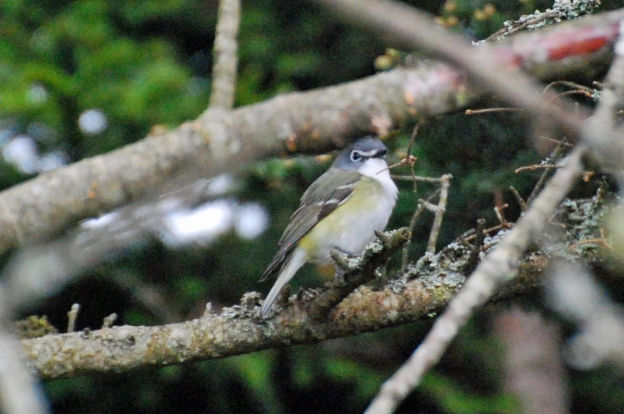
Photo by JudaM/Pixabay.com • Birds that nest at some high elevations, such as this red-breasted nuthatch, thrive at different locations in Unicoi County. A total of six red-breasted nuthatches were tallied on the recent Unicoi County Summer Bird Count.
The Elizabethton Bird Club holds two summer bird counts to supplement other population monitoring efforts on the birdlife of Tennessee. Six years ago, the club launched an annual survey of summer bird populations in Unicoi County.
The sixth annual Unicoi County Summer Count was held Saturday, June 15, with 16 observers in five parties. A total of 107 species was found, which is slightly below the average of 109 species. Unicoi County offers several high elevation species of birds not easily found in the region, according to compiler Rick Knight.
Knight noted that highlights for the count include sharp-shinned hawk, bald eagle, yellow-bellied sapsucker, least flycatcher, warbling vireo, common raven, red-breasted nuthatch, brown creeper, golden-crowned kinglet and hermit thrush. The count also found 18 species of warblers, including Swainson’s, Kentucky, magnolia and prairie.

Photo by Jean Potter • Golden-crowned kinglet is another high-elevation species found in Unicoi County during the summer.
The most common birds found in the count included American robin (241), European starling (224) indigo bunting (147) and song sparrow (146).
Some expected birds could not be found on the day of the count, including ruffed grouse, great horned owl, winter wren, Blackburnian warbler and pine warbler.
I counted with Dave and Connie Irick, Brookie and Jean Potter and Brenda Richards in the Limestone Cove community of Unicoi County. Some of our best birds included yellow-breasted chat, yellow-bellied sapsucker, rose-breasted grosbeak and Swainson’s warbler.
The total for this year’s Unicoi Bird Count follows:
Canada goose, 90; wood duck, 27; mallard, 33; wild turkey, 5; great blue heron, 2; and green heron, 3.

Photo by Bryan Stevens • Both black and turkey vultures were well represented on the Unicoi County Summer Bird Count.
Black vulture, 7; turkey vulture, 33; sharp-shinned hawk, 1; Cooper’s hawk, 1; bald eagle, 1; broad-winged hawk, 9; red-tailed hawk, 7; and American kestrel, 3.
Killdeer, 9; rock pigeon, 78; mourning dove, 70; yellow-billed cuckoo, 7; Eastern screech-owl, 1; and barred owl, 3.
Chuck-will’s widow, 3; Eastern whip-poor-will, 9; chimney swift, 37; ruby-throated hummingbird, 14; and belted kingfisher, 2.
Red-bellied woodpecker, 8; yellow-bellied sapsucker, 8; downy woodpecker, 17; hairy woodpecker, 1; Northern flicker, 8; and pileated woodpecker, 11.
Eastern wood-pewee, 4; Acadian flycatcher, 26; least flycatcher, 1; Eastern phoebe, 41; great crested flycatcher, 2; and Eastern kingbird, 8.
White-eyed vireo, 3; yellow-throated vireo, 1; blue-headed vireo, 23; warbling vireo, 2; and red-eyed vireo, 105.
Blue jay, 66; American crow, 84; common raven, 8; Northern rough-winged swallow, 53; purple martin, 40; tree swallow, 106; barn swallow, 152; and cliff swallow, 128.
Carolina chickadee, 69; tufted titmouse, 55; red-breasted nuthatch, 6; white-breasted nuthatch, 15; brown creeper, 3; house wren, 22; and Carolina wren, 60.
Blue-gray gnatcatcher, 20; golden-crowned kinglet, 4; Eastern bluebird, 62, veery, 11; hermit thrush, 3; wood thrush, 41; and American robin, 241.
Gray catbird, 25; brown thrasher, 11; Northern mockingbird, 27; European starling, 224; and cedar waxwing, 34.
Ovenbird, 36; worm-eating warbler, 17; Louisiana waterthrush, 10, black-and-white warbler, 15; Swainson’s warbler, 8; Kentucky warbler, 1; common yellowthroat, 10; hooded warbler, 75; American redstart, 2; Northern parula, 20; magnolia warbler, 1; yellow warbler, 6; chestnut-sided warbler, 9; black-throated blue warbler, 19; yellow-throated warbler, 15; prairie warbler, 1; black-throated green warbler, 17; Canada warbler, 8; and yellow-breasted chat, 2.
Eastern towhee, 46; chipping sparrow, 55; field sparrow, 7; song sparrow, 146; and dark-eyed junco, 17.
Scarlet tanager, 30; Northern cardinal, 64; rose-breasted grosbeak, 5; blue grosbeak, 3; and indigo bunting, 147.
Red-winged blackbird, 70; Eastern meadowlark, 9; common grackle, 71; brown-headed cowbird, 14; orchard oriole, 3; Baltimore oriole, 1; house finch, 19; American goldfinch, 92; and house sparrow, 18.
Unicoi County offers some great habitat for finding birds. In addition to the new state park, the county also offers Erwin Fishery Park and adjacent walking trails, as well as Unaka Mountain. The diversity of birds found on the summer count is a testament to the value of these habitats for birds and other wildlife.

Photo by Bryan Stevens • Green herons, such as this one, are found along the linear trail in Erwin during the summer months.










